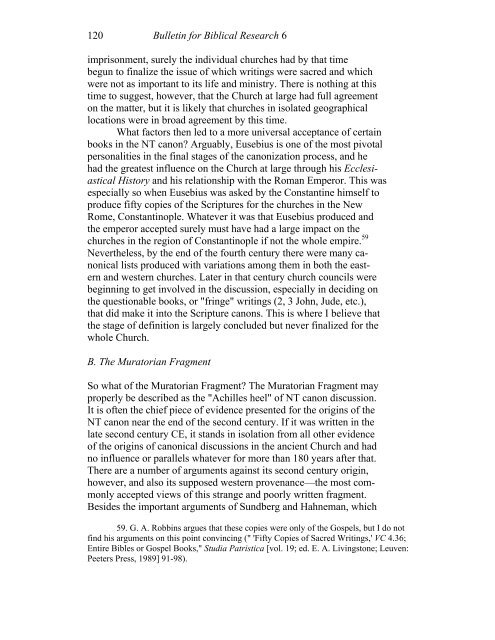The Integrity of the Biblical Canon in Light of Its Historical ...
The Integrity of the Biblical Canon in Light of Its Historical ...
The Integrity of the Biblical Canon in Light of Its Historical ...
You also want an ePaper? Increase the reach of your titles
YUMPU automatically turns print PDFs into web optimized ePapers that Google loves.
120 Bullet<strong>in</strong> for <strong>Biblical</strong> Research 6<br />
imprisonment, surely <strong>the</strong> <strong>in</strong>dividual churches had by that time<br />
begun to f<strong>in</strong>alize <strong>the</strong> issue <strong>of</strong> which writ<strong>in</strong>gs were sacred and which<br />
were not as important to its life and m<strong>in</strong>istry. <strong>The</strong>re is noth<strong>in</strong>g at this<br />
time to suggest, however, that <strong>the</strong> Church at large had full agreement<br />
on <strong>the</strong> matter, but it is likely that churches <strong>in</strong> isolated geographical<br />
locations were <strong>in</strong> broad agreement by this time.<br />
What factors <strong>the</strong>n led to a more universal acceptance <strong>of</strong> certa<strong>in</strong><br />
books <strong>in</strong> <strong>the</strong> NT canon? Arguably, Eusebius is one <strong>of</strong> <strong>the</strong> most pivotal<br />
personalities <strong>in</strong> <strong>the</strong> f<strong>in</strong>al stages <strong>of</strong> <strong>the</strong> canonization process, and he<br />
had <strong>the</strong> greatest <strong>in</strong>fluence on <strong>the</strong> Church at large through his Ecclesiastical<br />
History and his relationship with <strong>the</strong> Roman Emperor. This was<br />
especially so when Eusebius was asked by <strong>the</strong> Constant<strong>in</strong>e himself to<br />
produce fifty copies <strong>of</strong> <strong>the</strong> Scriptures for <strong>the</strong> churches <strong>in</strong> <strong>the</strong> New<br />
Rome, Constant<strong>in</strong>ople. Whatever it was that Eusebius produced and<br />
<strong>the</strong> emperor accepted surely must have had a large impact on <strong>the</strong><br />
churches <strong>in</strong> <strong>the</strong> region <strong>of</strong> Constant<strong>in</strong>ople if not <strong>the</strong> whole empire. 59<br />
Never<strong>the</strong>less, by <strong>the</strong> end <strong>of</strong> <strong>the</strong> fourth century <strong>the</strong>re were many canonical<br />
lists produced with variations among <strong>the</strong>m <strong>in</strong> both <strong>the</strong> eastern<br />
and western churches. Later <strong>in</strong> that century church councils were<br />
beg<strong>in</strong>n<strong>in</strong>g to get <strong>in</strong>volved <strong>in</strong> <strong>the</strong> discussion, especially <strong>in</strong> decid<strong>in</strong>g on<br />
<strong>the</strong> questionable books, or "fr<strong>in</strong>ge" writ<strong>in</strong>gs (2, 3 John, Jude, etc.),<br />
that did make it <strong>in</strong>to <strong>the</strong> Scripture canons. This is where I believe that<br />
<strong>the</strong> stage <strong>of</strong> def<strong>in</strong>ition is largely concluded but never f<strong>in</strong>alized for <strong>the</strong><br />
whole Church.<br />
B. <strong>The</strong> Muratorian Fragment<br />
So what <strong>of</strong> <strong>the</strong> Muratorian Fragment? <strong>The</strong> Muratorian Fragment may<br />
properly be described as <strong>the</strong> "Achilles heel" <strong>of</strong> NT canon discussion.<br />
It is <strong>of</strong>ten <strong>the</strong> chief piece <strong>of</strong> evidence presented for <strong>the</strong> orig<strong>in</strong>s <strong>of</strong> <strong>the</strong><br />
NT canon near <strong>the</strong> end <strong>of</strong> <strong>the</strong> second century. If it was written <strong>in</strong> <strong>the</strong><br />
late second century CE, it stands <strong>in</strong> isolation from all o<strong>the</strong>r evidence<br />
<strong>of</strong> <strong>the</strong> orig<strong>in</strong>s <strong>of</strong> canonical discussions <strong>in</strong> <strong>the</strong> ancient Church and had<br />
no <strong>in</strong>fluence or parallels whatever for more than 180 years after that.<br />
<strong>The</strong>re are a number <strong>of</strong> arguments aga<strong>in</strong>st its second century orig<strong>in</strong>,<br />
however, and also its supposed western provenance—<strong>the</strong> most commonly<br />
accepted views <strong>of</strong> this strange and poorly written fragment.<br />
Besides <strong>the</strong> important arguments <strong>of</strong> Sundberg and Hahneman, which<br />
59. G. A. Robb<strong>in</strong>s argues that <strong>the</strong>se copies were only <strong>of</strong> <strong>the</strong> Gospels, but I do not<br />
f<strong>in</strong>d his arguments on this po<strong>in</strong>t conv<strong>in</strong>c<strong>in</strong>g (" 'Fifty Copies <strong>of</strong> Sacred Writ<strong>in</strong>gs,' VC 4.36;<br />
Entire Bibles or Gospel Books," Studia Patristica [vol. 19; ed. E. A. Liv<strong>in</strong>gstone; Leuven:<br />
Peeters Press, 1989] 91-98).
















